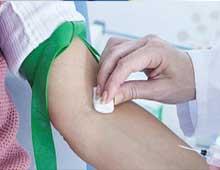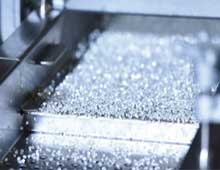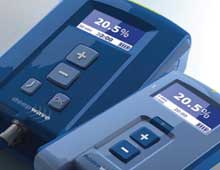Thermoplastic Elastomers: Medical devices come of age with TPEs
Also, download this story from the electronic issue here

Incorporating TPEs in the manufacture of medical devices allows for easier processing, just like thermoplastics, and imitating the performance and feel of thermoset rubbers, as well as lower scrap rates, thus assuring end-users of safe, hygienic, light weight and cost effective medical and health management solutions.
Market growth of TPEs
In a report titled The Future Thermoplastic Elastomers to 2022 research firm Smithers Rapra estimates that the market has grown at a compound average rate (CAGR) of 5.45% from 2012-2017. The market is expected to grow at about the same rate for 2017-22, with a CAGR of 5.58%.
The Asia-Pacific region will occupy an estimated 49.7% in 2017, and will likely grow to a market share of 25.5%.
The NAFTA region is the second-largest market, but its estimated market share of 25.5% is expected to recede slightly to 24.5% by 2022.
The European market share is third in line at 19.7% in 2017, but will likely fall to 17.8% in 2022. Meanwhile, the South American market is faring rather badly and will do so right up to 2022.
Innovations in medical devices
Health management will not be as advanced as it is today without the innovations in medical devices. Opportunity growth is driven by the introduction of innovative devices into the market, forecast to reach US$398 billion in the current year, from US$321 billion in 2012, and its revenue will show strong growth to 2023. This is stated by UK-based Visiongain in its report titled Medical Devices Industry and Market Prospects 2013-2023.
The research entity also attributes market expansions to the demand generated by illnesses associated with the ageing global population, including cardiac and respiratory diseases that generally affect the over-65 population. Plus, the growing middle class in emerging economies will result in a larger proportion of the population being able to afford procedures and treatments that were previously deemed too expensive, the report states.
On the other hand, the medical devices market is a boost to the TPE market for these kinds of applications. Currently, TPE manufacturers have been actively innovating products that will replace traditional elastomers and thermoplastics in a variety of applications.
Essentially latex-free solutions
In Visiongain’s TPE report, it cites that demand for PVCfree or non-latex medical applications are creating an impetus for the TPE market to grow, as well as given its advantage of being a cost-effective alternative to silicone.
Cast film products, such as tourniquets and straps, therapy bands and sheeting, and dental dams, now have new latex-free options from US firm Teknor Apex that has expanded its Medalist range of TPEs. The company says its TPEs offer the same elasticity, durability, and “feel” of latex without concerns regarding allergic reactions, odours, or the use of residual curing agents. Like other Medalist medical elastomers, the new compounds are made with FDA-compliant ingredients, are compliant with ISO 10993-5 and REACH SVHC, are free of phthalates, and are produced in ISO13485 facilities in the US and in Singapore.
Latex films are valued for their unique combination of elastic properties, including low ratio of force to elongation and low tensile set after elongation. The new Medalist compounds duplicate the elastic behaviour of latex while providing similar resilience and durability as well as haptics (tactile qualities) and draping behaviour.

The firm also says Medalist TPEs permit major cost savings over latex and other thermoset rubbers, such as nitrile or neoprene, due to the elimination of the curing step.
Medical grade compounds producer Colorite also
launched Cellene suitable for a wide variety of uses
in medical devices, packaging and other regulated
markets. The Tekni-Plex company says that its Cellene compounds are formulated to be silicone,
 latex, phthalate, halogen and PVC-free using FDAcompliant
raw materials to meet USP Class VI and
ISO 10993 standards.
latex, phthalate, halogen and PVC-free using FDAcompliant
raw materials to meet USP Class VI and
ISO 10993 standards.
US-based compounder PolyOne has designed its Versaflex HC TPE grade to resist the disinfectants used in HAI prevention. The materials are processed by two-shot injection moulding and are compatible with rigid PVC, copolyesters, all PC alloys, ABS, TPUs and PEI substrates. Typical applications include device housings for hand-held scanners, patient monitors, infusion pumps, defibrillators, reusable surgical devices and other durable medical products.

In addition, a new styrenic TPE for wire and cable in medical devices has been launched by Teknor Apex: Medalist MD458. The firm says it is an exact analogue of its 20-year old Elexar EL9431, which has been used in non-medical wire and cable applications. Formulated on request by medical-industry OEMs, Medalist MD458 is a high-purity version that has passed ISO 10993-5 cytotoxicity testing. It has also passed standard tests for oil resistance after seven days at 60 C and UV resistance after 720-hour exposure.
New grades for robust applications
With the development of Thermolast M, German manufacturer Kraiburg TPE says it is able to offer compounds that are approved for use in direct contact with blood and medications. Further, these materials can be coloured in conformity with medical compliant requirements and open up new potential fields of applications in the medical and pharmaceutical sectors like medical packaging, hospital care and resealing membranes.

The materials are certified according to DIN ISO 10993-5 (cytotoxicity), -10 (intracutaneous irritation), -11 (acute system toxicity), USP Class VI and DIN ISO 10993-4 (hemolysis). Plus, Kraiburg says its compounds can conform to cleanroom processing standards, are able to be sterilised with gas, radiation, plasma and permit steam sterilisation.
US firm Kraton Performance Polymers, a producer of styrenic block copolymer (SBC), has developed Kraton G1653 polymer, a styrene-ethylene-butylenestyrene (SEBS) block copolymer, with a lower molecular weight than Kraton G1652 polymer, but with high tensile strength and toughness of G1652 while offering lower melt and solution viscosities.
Kraton says the low solution viscosity increases solid content and decreases VOC of solvent based products, yet maintains similar processability. For coating applications, the increased solid level translates to potentially reduce coating layers and lower labour costs. For sealant applications, the increased solid content is expected to reduce shrinkage and costs associated with solvent.
G1653 also can be dissolved in PCBTF at 20% solids, which may enable formulators to replace organic solvents with PCBTF to reduce VOCs associated with the final product. The free flowing dense pellet form of G1653 is expected to improve storage, handling, and feeding of the polymer in comparison to SEBS polymers in powder form.
Potential market applications include coating applications, sealants, pressure sensitive adhesives, hot melt adhesives, TPE compound, elastic compound, medical compound, colour master batch, additive concentrates, oil gel, and polymer modification.
Since G1653 has the same low rubber phase Tg (-48.5°C) as the conventional G1600 series polymers, it allows the polymer to remain flexible and elastic at low temperatures. When compounded with a random co-PP and extruded into clear films, the robustness is especially useful for medical applications, says Kraton. These films can be heat sealed and sterilised.
Providing soft touch treatment
TPEs serve the market requirement for soft feel/touch application and this is a vital aspect especially for medical devices.
The use of sedation in medical procedures is increasing as a result of more sophisticated surgical techniques, an ageing population, and a greater incidence of obesity. Thus, US-based Revolutionary Medical Devices (RMD) has developed the first nasalonly oxygenation mask, SuperNO2VA, which uses Teknor Apex’s Medalist MD-10105.
Unlike full-face masks, SuperNO2VA provides easy access to the oral cavity and is designed to deliver a greater flow of oxygen under positive pressure to the patient’s airways. The single-use mask consists of a transparent rigid PP component with access ports for an anesthesia circuit or hyperinflation bag, plus a TPE cushion that is over-moulded onto the PP structure.
RMD uses the China-based contract moulding subsidiary of a US company to injection mould the components for the SuperNO2VA mask. The cushion part is produced in blue, green, pink, or yellow for purposes of colour-coding, with Medalist MD-10105 supplied in pre-coloured compounds. RMD has also recently obtained a patent for its SuperNO2VA mask.
Foot care aid for athletes
TPEs can also aid athletes whose primary opponent is foot ailment. Gel technology specialist Silipos recently launched Silipos Active, a new line of foot support products for prevention and relief of pain associated with a variety of common ailments.
The US-headquartered firm stated that the TPE
 gel line includes 16 different products that help
prevent and treat a variety of issues such as corns,
calluses, ingrown toenails, blisters, bunions, Achilles
tendonitis, bursitis, sprains, and general foot pain.
gel line includes 16 different products that help
prevent and treat a variety of issues such as corns,
calluses, ingrown toenails, blisters, bunions, Achilles
tendonitis, bursitis, sprains, and general foot pain.
Silipos is the original manufacturer of podiatry TPE gels, which are made with a proprietary formula of medical-grade mineral oil. In comparison, many other gel products are made from less refined oil, which contain a higher number of impurities and toxic substances, says Silipos.
(PRA)Copyright (c) 2017 www.plasticsandrubberasia.com. All rights reserved.



















































